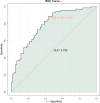Characteristics of symptoms and establishment of a predictive model for PICS in mechanically ventilated patients with severe pneumonia: a retrospective study
- PMID: 40211419
- PMCID: PMC11983978
- DOI: 10.1186/s40001-025-02547-x
Characteristics of symptoms and establishment of a predictive model for PICS in mechanically ventilated patients with severe pneumonia: a retrospective study
Abstract
Purpose: The study aimed to characterize the symptoms of post-intensive care unit (ICU) syndrome in mechanically ventilated patients with severe pneumonia and establish a predictive model for this syndrome.
Methods: A retrospective study was conducted on critically ill pneumonia patients requiring mechanical ventilation. Patients were categorized into non-ICU-acquired complication and post-intensive care syndrome (PICS) groups based on the development of ICU-acquired complications. Various demographic, clinical, laboratory, imaging, and symptom-related parameters were collected and analyzed.
Results: A total of 133 patients including 62 patients with non-ICU-Acquired Complications Group and 71 patients with PICS Group were included. Significant differences between the non-ICU-acquired complication and PICS groups were observed in demographic characteristics, such as age, body mass index (BMI), and Acute Physiology and Chronic Health Evaluation (APACHE) II score (p < 0.05). Clinical parameters, including PaO2/FiO2 (P/F) ratio, white blood cell (WBC) count, serum creatinine, and procalcitonin levels, showed statistical significance (p < 0.05). Ventilation and ICU stay characteristics, laboratory parameters at 72 h, imaging findings, and symptom characteristics also displayed significant differences between the groups (p < 0.05). The study's joint model exhibited an area under the curve (AUC) value of 0.786 (95% CI 0.746-0.833), indicating a moderate-to-good predictive value for PICS.
Conclusion: The study's findings highlight the potential utility of a multi-faceted predictive model integrating demographic, clinical, laboratory, imaging, and symptom-related parameters for identifying patients at risk for PICS.
Keywords: Mechanically ventilated; PICS; Predictive model; Severe pneumonia; Symptoms.
© 2025. The Author(s).
Conflict of interest statement
Declarations. Ethics approval and consent to participate: This study received approval from the Institutional Review Board and Ethics Committee of the Nantong Third People's Hospital, Affiliated Nantong Hospital 3 of Nantong University. Based on the guidelines set forth by our institution's Institutional Review Board and Ethics Committee, informed consent was waived for this retrospective study as it solely involved de-identified patient data, thus presenting no risk or impact on patient care. Competing interests: The authors declare no competing interests.
Figures
Similar articles
-
Mortality prediction in community-acquired pneumonia requiring mechanical ventilation; values of pneumonia and intensive care unit severity scores.Tuberk Toraks. 2010;58(1):25-34. Tuberk Toraks. 2010. PMID: 20517726
-
[Predictive value of glycosylated serum protein combined with glycemic variability on secondary persistent inflammatory immunosuppressed catabolic syndrome prediction in elderly septic patients].Zhonghua Wei Zhong Bing Ji Jiu Yi Xue. 2018 Nov;30(11):1051-1055. doi: 10.3760/cma.j.issn.2095-4352.2018.011.008. Zhonghua Wei Zhong Bing Ji Jiu Yi Xue. 2018. PMID: 30541644 Chinese.
-
[A retrospective clinical study of sixty-three cases with persistent inflammation immunosuppression and catabolism syndrome].Zhonghua Nei Ke Za Zhi. 2016 Dec 1;55(12):941-944. doi: 10.3760/cma.j.issn.0578-1426.2016.12.007. Zhonghua Nei Ke Za Zhi. 2016. PMID: 27916049 Chinese.
-
[Analysis of prognosis risk factors of critically ill patients after cardiac surgery: a consecutive 5-year retrospective study].Zhonghua Wei Zhong Bing Ji Jiu Yi Xue. 2019 Jul;31(7):873-877. doi: 10.3760/cma.j.issn.2095-4352.2019.07.015. Zhonghua Wei Zhong Bing Ji Jiu Yi Xue. 2019. PMID: 31441413 Chinese.
-
[Risk factors for death in elderly patients admitted to intensive care unit after elective abdominal surgery: a consecutive 5-year retrospective study].Zhonghua Wei Zhong Bing Ji Jiu Yi Xue. 2021 Dec;33(12):1453-1458. doi: 10.3760/cma.j.cn121430-20210804-00118. Zhonghua Wei Zhong Bing Ji Jiu Yi Xue. 2021. PMID: 35131012 Chinese.
References
-
- Pant U, Vyas K, Meghani S, Park T, Norris CM, Papathanassoglou E. Screening tools for post-intensive care syndrome and post-traumatic symptoms in intensive care unit survivors: a scoping review. Aust Crit Care. 2023;36:863–71. - PubMed
-
- Luetz A, Grunow JJ, Mörgeli R, Rosenthal M, Weber-Carstens S, Weiss B, Spies C. Innovative ICU solutions to prevent and reduce delirium and post-intensive care unit syndrome. Semin Respir Crit Care Med. 2019;40:673–86. - PubMed
-
- Hegazy SK, Hassan AH. Comparing the efficacy of remdesivir, favipiravir, and casirivimab and imdevimab on duration of hospitalization and ICU stay of hospitalized COVID-19 patients. Life Sci Res Commun. 2024;1:21–30.
-
- Hassan AH, Hegazy SK, Radwan ST. Clinical study to evaluate the possible efficacy and safety of antibodies combination (casirivimab and imdevimab) versus standard antiviral therapy as antiviral agent against Corona virus 2 infection in hospitalized COVID-19 patients. MedRxiv. 2022. 10.1101/2022.08.20.22279020.
-
- Hegazy SK, Hassan AH. The effect of combination treatment with casirivimab and imdevimab versus standard antiviral therapy on clinical outcomes in hospitalized COVID-19 patients. Discov Med. 2024;1:71.
MeSH terms
Grants and funding
LinkOut - more resources
Full Text Sources
Medical



